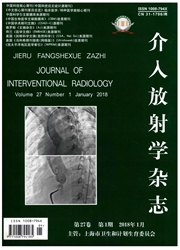

 中文摘要:
中文摘要:
目的建立用于测试颅内支架性能的颈内动脉虹吸段动物模型。方法使用快速原型及脱蜡技术建立6只颈内动脉虹吸段约束装置。手术暴露并游离6只犬双侧颈总动脉。左侧颈总动脉近端暂时性夹闭,远端结扎并沿结扎点近侧切断。右侧颈总动脉远端暂时性央闭,近端结扎并沿结扎点远侧切断。左侧颈总动脉近侧段穿过塑型装置,并与右侧颈总动脉远侧游离段端端吻合。术后1、2周、1个月血管造影,视觉评估虹吸段模型形态,血管通畅,吻合口狭窄及附壁血栓形成情况。结果所有实验犬均能耐受手术,无一只死亡或出现神经功能障碍。建模平均手术时间90min。术后1、2周、1个月血管造影,显示虹吸段模型空间结构与其人体原形高度相似,2例发生吻合口狭窄,1例吻合口附壁血栓形成。所有模型虹吸段随访中均保持通畅。结论采用体外约束装置,手术建立虹吸段模型切实可行,该模型具有高度可重复性、可靠性,可用于测试神经血管内材料。
 英文摘要:
英文摘要:
Objective To develop in vivo carotid siphon models by surgical method using the shaped devices for testing the performance of covered stent specially designed for intracranial vascular diseases. Methods Six carotid siphon-shaped devices were established using sterolithographie biomodeling and the lost-wax technique. Six canines underwent surgery to expose and isolate bilateral CCA. The fight CCA origin was ligated and incised distal to the ligation point after the distal right CCA was temporarily closed. The distal left CCA was ligated and incised proximal to the ligation point after the left CCA origin was closed. The proximal isolated left CCA was passed through the shaped device. The distal isolated fight CCA and the proximal isolated left CCA were anastomosed end-to-end. Finally, the shaped device of carotid siphon was fixed with suture and embedded in the left neck. The intraarterial DSA was performed on postprocedural 7 days, 2 weeks and 1 month. The morphological characteristics of carotid siphon models were visually evaluated by two observers. The pateney of siphon model and the stenosis of anastomotie stoma were followed- up. Results All animals tolerated the surgical procedure well with mean model time construction of 90 minutes. The morphological characteristics of siphon models were similar to those in human. The anastomotie stoma stenosis occurred in 2 siphon models, and thrombosis of anastomotie stoma in 1, but all siphone of these models were patent on post-procedural follow-up angiography. Conclusion Surgical construction of an in vivo carotid siphon model of canine with shaped device is practically feasible. This model can be used for testing neurovaseular devices.
 同期刊论文项目
同期刊论文项目
 同项目期刊论文
同项目期刊论文
 期刊信息
期刊信息
